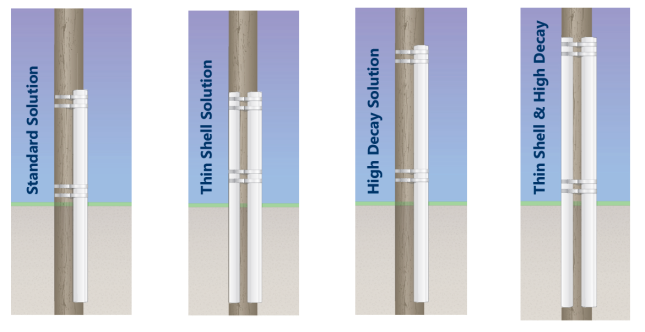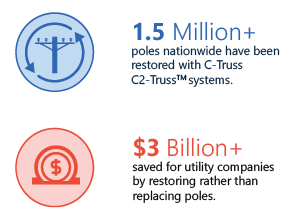Contact your local Osmose professional.
Wood Pole Restoration
Osmose pole restoration systems provide reliable, long-term solutions for extending service life. Osmose restoration systems:
- Restore poles to code-mandated strength
- Add decades of service life
- Save you money - pole restoration is often one-third or less than the cost of replacement
- Improve structural resiliency of the grid
- Help you avoid the hassle of replacement, which includes change-outs, transfers, double wood, and service interruptions
As a world leader in wood pole inspection and restoration, Osmose technicians are experts at evaluating a pole’s remaining strength and suitability for restoration.
This includes using preservatives to control decay and protect the remaining serviceable wood to ensure the longevity of the newly-restored pole and the overall integrity of your plant.
MORE STRENGTH, LESS COST
Below 2/3 of NESC required structure strength, poles must be restored or replaced.
Restoration can bring poles back above code compliance for 1/3 or less of replacement cost.

Pole restoration extends useful life and can be funded with 100% capital dollars without any O&M expense. Contact your local Osmose professional to learn more.
Restore vs. Replace
If a pole’s strength falls below code requirements due to decay or damage, the pole is considered a “reject” and must be restored or replaced. In the United States, utilities generally follow minimum criteria established by the National Electrical Safety Code (NESC) or California’s General Order 95 (GO95) by restoring or replacing a pole that is evaluated to have less than 67% of its original bending strength.

Osmose Truss Systems
When bending loads are applied to a reinforced pole, they are transferred to the truss. The truss allows the bending loads to effectively bypass the decayed or damaged groundline area of the pole, transferring the loads to sound wood foundation below ground.
Long-lasting Impact
On average, Osmose trusses can extend the useful life of wood poles by 30 years or more. Osmose truss systems are engineered for safety and reliability, and have been thoroughly tested and proven throughout their 55-year history. No other pole restoration system has a comparable history of success in actual field applications.
-
1965
Birth of the original c-shaped truss.
-
1970s
Introduction of high strength steel-plate material.
-
1980s
- Optimized for NESC code.
- Increased size range.
-
1990s
Capacity upgrade solutions developed.
-
2000s
- C2-Truss introduced.
- Higher strength, lighter weight.
- Improved efficiency.
-
2010s
Additional sizes added for telco market.
-
2020s
- Continued truss innovation.
- Enhanced life extension analytics.
Trussing Options
The patented C2-Truss systems restore common distribution size poles with an optimized design that provides a more efficient, lighter weight, lower cost truss. The Osmo-C-Truss systems typically restore transmission and larger distribution-size poles.
Truss solutions can be adapted based on pole conditions. For more advanced decay (thinner shell applications), double trusses can be utilized. For decay that has progressed beyond standard installation heights, a taller truss is the best solution.


.png?width=243&name=Osmose-logo-(white).png)